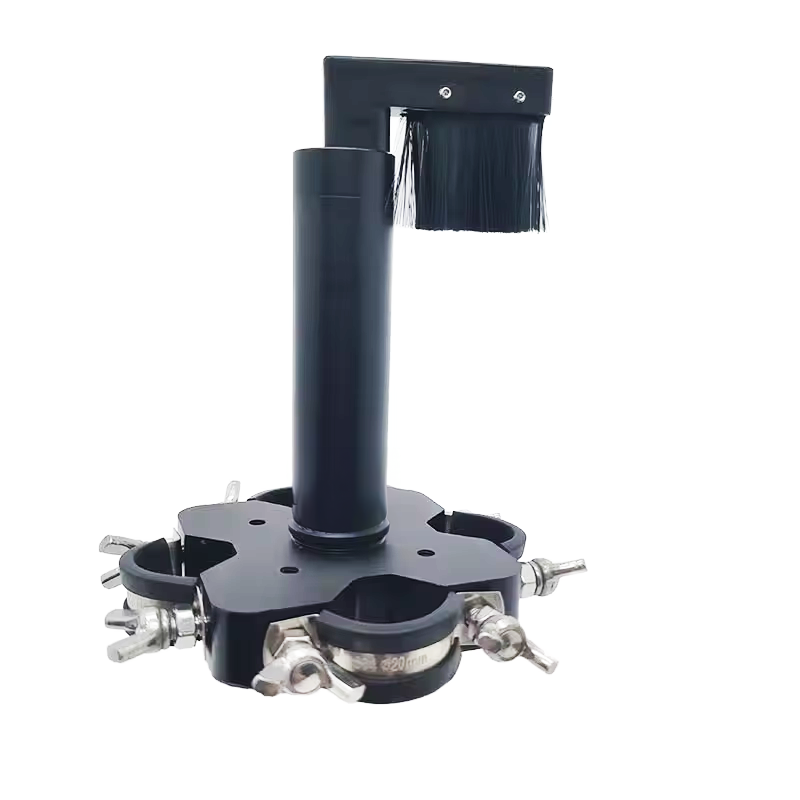In the field of water quality monitoring, continuity and accuracy of data are the lifelines. However, whether in river, lake, and sea monitoring stations or the biochemical pools of wastewater treatment plants, water quality sensors are chronically exposed to extremely harsh environments—algae growth, biofouling, chemical scaling, and particle accumulation all relentlessly compromise sensor sensitivity. Traditional reliance on frequent manual cleaning is not only time-consuming, labor-intensive, and costly but also comes with numerous pain points such as inconsistent cleaning results, potential sensor damage, and data interruption.
To address this, the Automatic Cleaning Device (automatic cleaning brush) we developed specifically for water quality sensors has emerged. It is redefining the standards of modern water quality monitoring maintenance.
I. Applications: The Ubiquitous Intelligent Cleaning Expert
This automatic cleaning device is flexibly designed and highly compatible, making it suitable for a wide range of monitoring scenarios plagued by fouling:
- Environmental Online Monitoring:
- Surface Water Monitoring Stations: Deployed at national and provincial control point automatic water quality stations to regularly clean sensors for pH, Dissolved Oxygen (DO), Turbidity (NTU), Permanganate Index (CODMn), Ammonia Nitrogen (NH3-N), etc. Effectively addresses issues from algae and sediment, ensuring continuous and reliable data reporting.
- Municipal Wastewater Treatment:
- Inlet and Outlet Points: Removes fouling caused by grease, suspended solids, etc.
- Biological Treatment Units: In key process points like aeration tanks and anaerobic/aerobic tanks, prevents thick biofilm formation from activated sludge mixtures on sensor probes, ensuring accuracy of process control parameters.
- Industrial Process and Effluent Monitoring:
- Widely used in effluent treatment facilities and discharge points of industries like food, pharmaceuticals, chemicals, and electroplating. Effectively handles scaling from more complex and adhesive special pollutants.
- Aquaculture and Aquatic Scientific Research:
- Maintains clean water parameter sensors in Recirculating Aquaculture Systems (RAS) or large breeding ponds, safeguarding healthy fish growth. Also provides an unattended automated solution for long-term field ecological research.
II. Core Benefits: From “Cost Center” to “Value Engine”
Deploying an automatic cleaning device offers far more than just “replacing manpower”; it delivers multidimensional value enhancement:
1. Ensures Data Accuracy and Continuity, Enhances Decision Reliability
- Function: Regular, efficient automated cleaning fundamentally eliminates data drift, distortion, and signal attenuation caused by sensor fouling.
- Value: Ensures monitoring data truly reflects water quality conditions, providing a solid and trustworthy data foundation for environmental early warnings, process adjustments, and compliance discharge. Avoids decision-making errors or environmental risks due to inaccurate data.
2. Significantly Reduces Operational Costs and Labor Input
- Function: Completely liberates technicians from frequent, arduous, and sometimes dangerous (e.g., heights, harsh weather) cleaning tasks. Enables 7×24 unattended automated operation.
- Value: Directly saves over 95% of labor costs associated with sensor cleaning. Maintenance personnel can focus on higher-value work like data analysis and system optimization, significantly improving workforce efficiency.
3. Extends Core Sensor Lifespan, Reduces Asset Depreciation
- Function: Compared to potential improper manual cleaning (e.g., scratching sensitive membranes, excessive force), the automatic cleaning device features intelligent pressure control and non-abrasive brush materials, ensuring a gentle, uniform, and controlled cleaning process.
- Value: Greatly reduces sensor damage caused by improper cleaning, effectively extending the service life of these expensive and precise instruments, directly lowering asset replacement and spare parts inventory costs.
4. Enhances System Stability and Safety
- Function: Avoids frequent starts/stops of the monitoring system or data stream interruptions due to manual maintenance, ensuring seamless continuity of monitoring operations.
- Value: Meets environmental regulatory requirements for data capture rates (often >90%). Also reduces the number of times personnel need to enter hazardous areas (e.g., sewage pools, steep banks), improving safety standards.
Conclusion
The automatic cleaning device for water quality sensors is no longer a simple “add-on accessory” but core infrastructure for building an intelligent, highly reliable water quality monitoring system. It solves long-standing inherent pain points in the industry, transforming the maintenance model from passive, inefficient human intervention to proactive, efficient automated prevention.
Investing in an automatic cleaning device is an investment in data quality, operational efficiency, and long-term asset health. Let’s work together to embrace smart operations and maintenance, ensuring every measurement is accurate and making cleaning no longer an obstacle to understanding water quality.
We can also provide a variety of solutions for
1. Handheld meter for multi-parameter water quality
2. Floating Buoy system for multi-parameter water quality
3. Automatic cleaning brush for multi-parameter water sensor
4. Complete set of servers and software wireless module, supports RS485 GPRS /4g/WIFI/LORA/LORAWAN
For more water sensor information,
please contact Honde Technology Co., LTD.
Email: info@hondetech.com
Company website: www.hondetechco.com
Tel: +86-15210548582
Post time: Aug-20-2025


